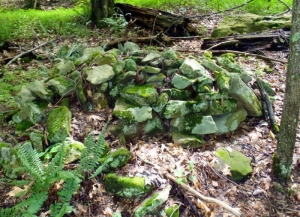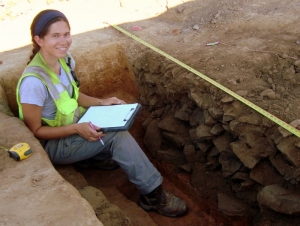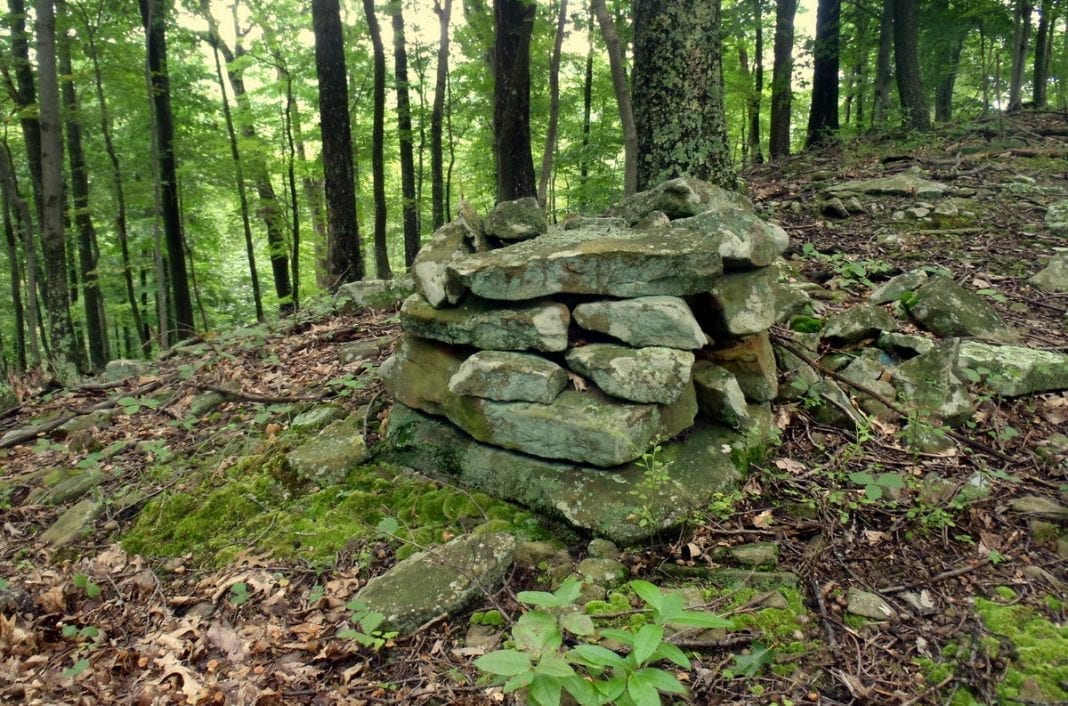Editor's Note: If you're familiar with the outdoors in West Virginia, you've likely seen rocks piled in what might seem "the middle of nowhere." Many were stacked by settlers and farmers, but others are prehistoric and sacred, according to archaeologist Charity Moore, who's cataloging their forms and locations.
During a routine archaeological survey in Doddridge County, a colleague and I came across a large split boulder, immediately followed by two short, square rock piles on either side of a narrow ridgetop. After passing between the square piles, we found ourselves in the middle of a “field” of stacked, oval rock piles on a steep hillside.
The piles captured my imagination, especially because I couldn’t find any information about them in West Virginia, outside of a few blogs and photos by avid hikers or curious amateur researchers. After talking to other archaeologists, they admitted to just walking by similar sites because they weren’t sure what they were or how to deal with them. I decided that I wanted to put West Virginia rock features on the map, because—as a non-native transplant—I want to show others that my adopted home state has a lot to contribute to the archaeological record.

Rock features were built by both Native Americans and white settlers for a wide variety of reasons. They can vary from monumental stone mounds to short wall segments to “fields” of small, irregular piles also known as cairns. Because stone is so durable, it can be very difficult to tell the difference between a prehistoric and a recent rock pile. This longevity is likely why stone was used by Native Americans and why rock features are found worldwide.
Those in West Virginia are enigmatic—we can’t ask their builders what they were doing because they lived thousands of years ago or were pushed out after European American contact.
When you look at oral tradition by surviving groups in other parts of the northeastern United States, it seems likely that these piles had many different purposes. Some were likely trail markers, with Native Americans adding their own stone as they passed by. Others may have been places of prayer and vision quests, especially those in the outlines of animals. Others may have been symbolic graves or memorials to ancestors.
The closest we currently have to an interpretation of West Virginia’s rock features comes from a statement by the United South and Eastern Tribes, who claim our area as part of their ancestral homeland and who issued a resolution in 2007 stating that their medicine people used the ceremonial stone landscapes “to sustain the people’s reliance on Mother Earth and the spirit energies of balance and harmony.”
Different types of rock features are found all across the United States, but there seems to be a unique tradition in West Virginia. Rather than being located in the floodplains, where people would have been living, rock features here are found in remote, upland locations overlooking head-water streams and other water sources.
They are often found near rock outcrops and other impressive natural features. They are almost always just below the ridgetops, rather than on top, where they can look up at the sky with the ridgetop silhouetted against it. Archaeologists call these types of locations “liminal” because they are outside the areas that would have been used in daily life and may have been seen as sacred places between the earth and sky.
Most importantly, you should never take apart or dig inside a rock feature. It is very rare that they contain artifacts, so you are unlikely to find any arrowheads or other relics of value. You could even disturb a cremation burial without knowing it. Because many rock features are considered sacred by modern Native American groups, even archaeologists are hesitant to disturb them.
If you find rock features on your property, taking pictures, measurements, and notes could be very important to researchers. Even old field-clearing piles are important because they provide a comparison to help identify the prehistoric ones. Look for clues about the feature’s origin, such as plow scars on stones, nearby fence lines, uniquely colored stones, nearby springs, and rock outcrops with petroglyphs.
Take photos of the feature as well as the surrounding landscape and views from the feature. I am currently working on a database of known sites across West Virginia, as part of the West Virginia Rock Feature Project (WVRFP) and would love to help you understand and document your site.
Think you've found an archaeological site in West Virginia? Click here to find out what to do next.

Charity Moore is a director and social media manager with the Council for West Virginia Archaeology.
A Pennsylvania native who received her graduate degree in England, she is employed by a West Virginia environmental consulting firm and is passionate about researching the archaeology of her new home state.
Sign up to receive of FREE copy of West Virginia Explorer Magazine in your email weekly. Sign me up!


